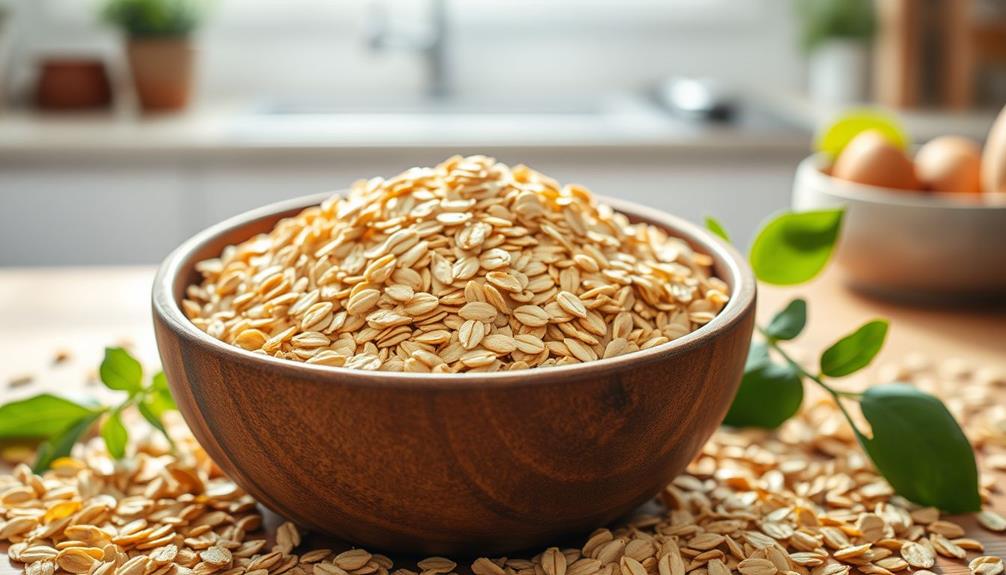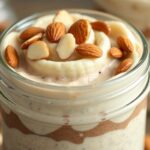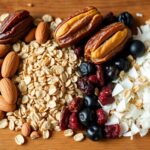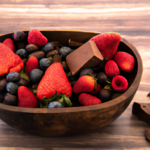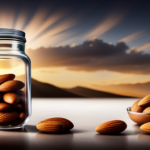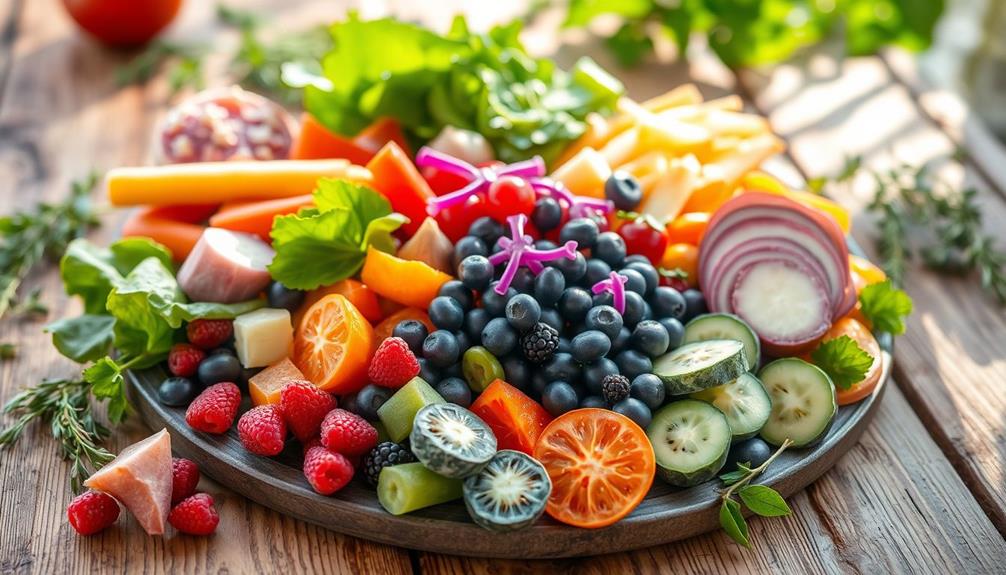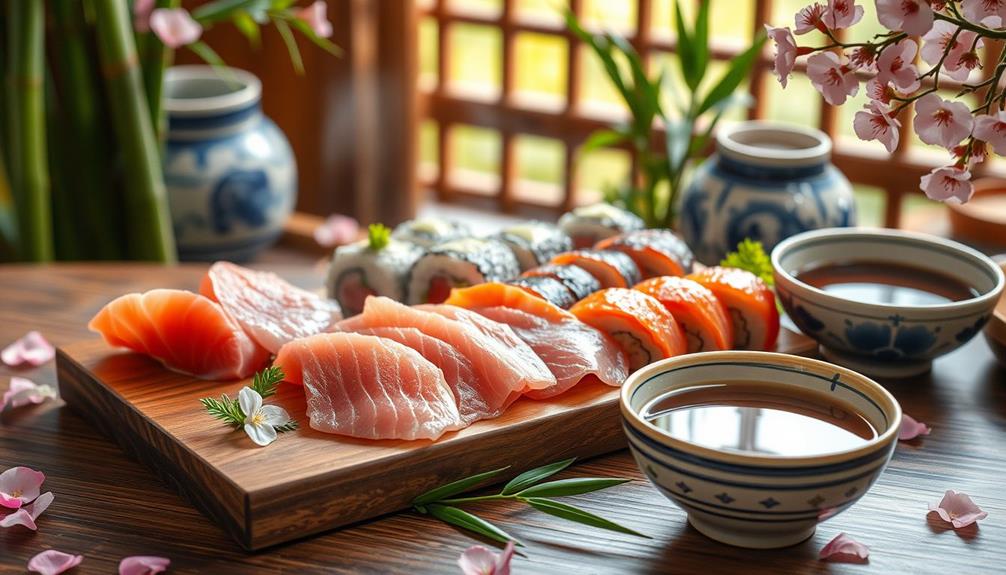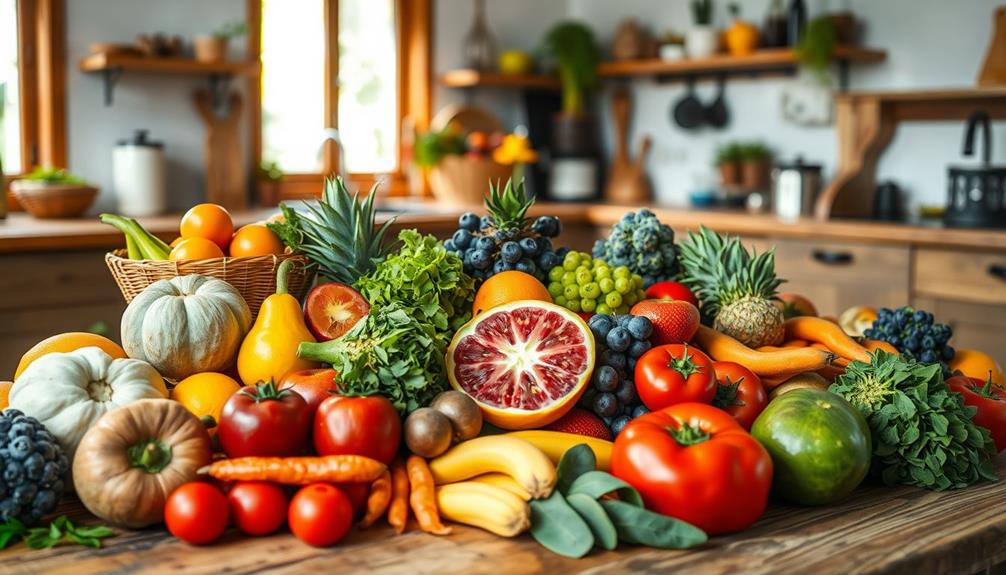Yes, oats can be considered raw food, especially when they're soaked. This soaking process enhances digestibility and maximizes nutrient absorption, allowing you to enjoy their health benefits fully. While raw oats contain essential nutrients and are rich in fiber, eating them dry might lead to indigestion for some. Soaking or incorporating raw oats into recipes like overnight oats keeps them nutritious while making them easier to digest. Remember, sourcing high-quality, non-heat-treated oats is key to reaping all the advantages. If you're curious about the best ways to prepare oats, you'll find some interesting options ahead.
Key Takeaways
- Oats can be considered raw food when consumed without cooking, but they should ideally be soaked for better digestibility and nutrient absorption.
- Raw oats contain phytic acid, which can inhibit mineral absorption, making soaking essential for optimal health benefits.
- While raw oats retain more heat-sensitive nutrients, cooking enhances digestibility by breaking down anti-nutritional factors.
- Quality sourcing of raw oats is crucial to avoid potential pathogen contamination from unprocessed grains.
- Alternatives to oats, like quinoa and buckwheat, can also be consumed raw and provide similar nutritional benefits.
Understanding Oats and Nutrition
Oats, often hailed as a nutritional powerhouse, are a whole grain packed with essential nutrients that can greatly benefit your health. When you choose oats, you're not just getting a tasty breakfast option; you're also fueling your body with significant amounts of fiber, protein, vitamins, and minerals, including magnesium and B vitamins.
One of the standout features of oats is their high content of soluble fibers, particularly beta-glucan. This type of fiber has shown promising effects, linked to a reduction in cholesterol levels and improved blood sugar control. Additionally, incorporating oats into your diet may help manage conditions like gout symptoms due to their low purine content.
However, raw oats can contain phytic acid, which may hinder mineral absorption. To maximize the nutritional benefits, soaking raw oats for at least 12 hours is a smart move. This process enhances digestibility and reduces phytic acid levels, making it easier for your body to absorb crucial minerals.
Whether you opt for rolled or steel-cut oats, the processing steps guarantee that you enjoy both safety and nutrition. So, when you incorporate oats into your diet, you're not just enjoying a meal; you're also making a positive choice for your overall nutrition.
Health Benefits of Oats
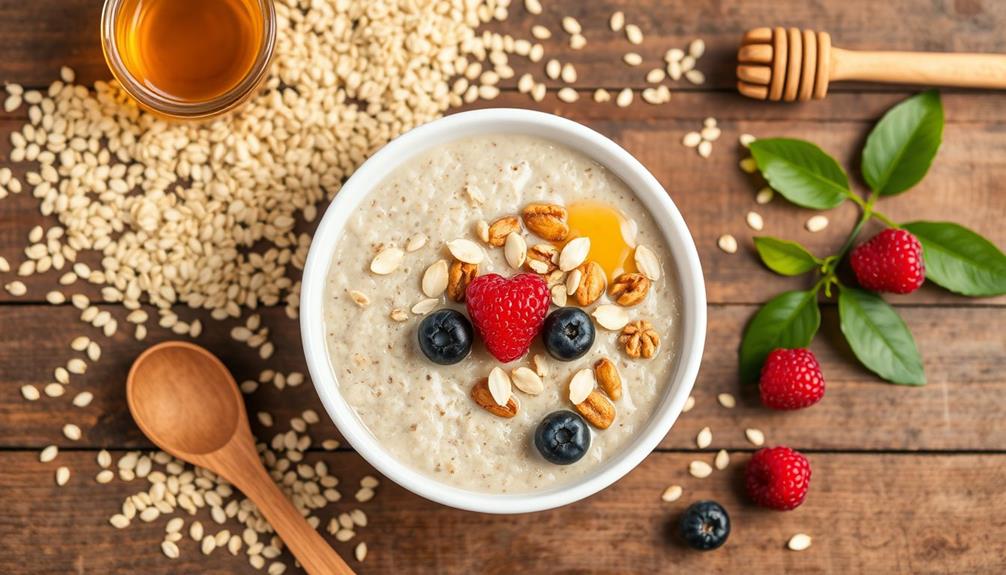
Discover the remarkable health benefits that come with incorporating oats into your diet. Whether you choose raw oats or oat bran, you're making a smart choice for your overall health. Here are some compelling reasons to enjoy oats regularly:
– Cholesterol Reduction: The soluble fiber found in oats, especially beta-glucan, can lower cholesterol levels by 5-10% when consumed consistently.
Additionally, oats provide a rich source of antioxidants, contributing to overall health and wellness, which can be beneficial in managing cholesterol levels rich in antioxidants.
- Glycemic Control: Consuming just 4g of beta-glucan daily has been linked to a 46% reduction in post-meal blood sugar levels, helping you maintain better glycemic control.
- Digestive Health: The dietary fiber from oats can increase stool weight by 3.4g for every gram of fiber consumed, promoting digestive health and relieving constipation.
- Weight Management: Oats enhance feelings of fullness, supporting appetite regulation and potentially aiding in weight management.
Preparation Methods for Oats
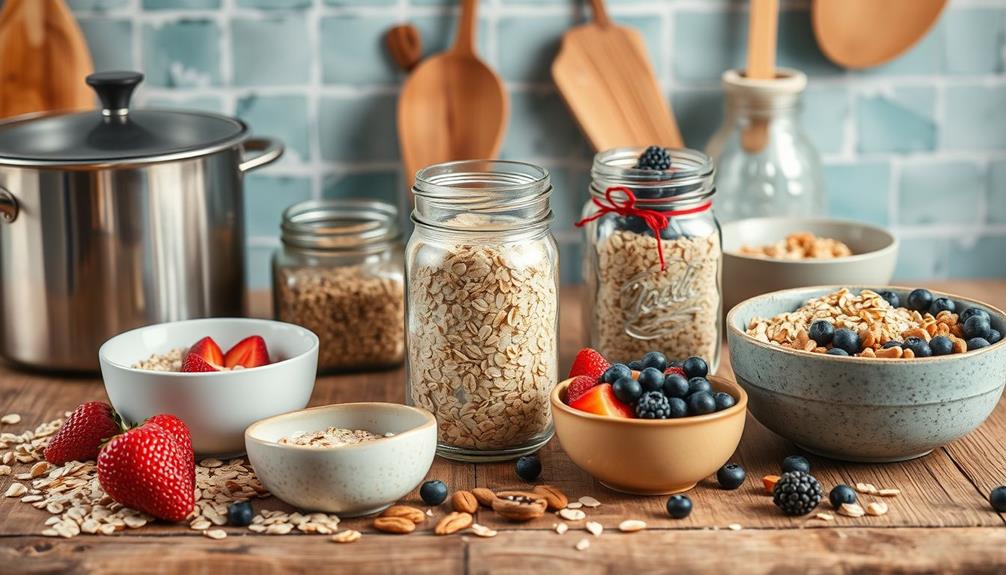
When you're looking for versatile and nutritious meal options, oats offer a variety of preparation methods that cater to different tastes and lifestyles. One popular choice is overnight oats, where you soak raw oats in liquid overnight. This method provides a quick and nutritious breakfast that's ready to go in the morning, making it an ideal start to your day.
Additionally, incorporating oats into energy-boosting snacks aligns with the idea of unique offerings that can enhance your daily routine.
If you're in the mood for a snack, consider making energy balls by mixing raw oats with dried fruits and nuts. These no-bake snacks are easy to prepare and packed with energy. You can also whip up no-bake cookies or brownies using raw oats, allowing you to enjoy their texture and nutritional benefits without cooking.
For a revitalizing breakfast, try muesli, a cold cereal made from rolled oats, grains, and dried fruits. Soak it in yogurt or milk for added flavor and texture.
Risks of Eating Raw Oats

Eating raw oats can be a nutritious choice, but there are some risks to reflect upon. While rolled oats can be a great addition to your diet, consuming them raw without proper preparation may lead to some digestive issues and nutrient absorption challenges.
Additionally, incorporating a balanced diet rich in fruits and vegetables, along with regular physical activity, can enhance your overall health and mitigate some of these risks sustainable weight loss.
Here are some risks to reflect upon:
- Indigestion: Dry raw oats can be harder to digest, potentially causing indigestion or constipation if not soaked beforehand.
- Nutrient absorption: Raw oats contain phytic acid, which can inhibit the absorption of essential minerals, possibly leading to deficiencies.
- Digestibility: Soaking raw oats for at least 12 hours can greatly improve their digestibility, making nutrients more bioavailable.
- Pathogen contamination: If raw oats aren't sourced from reputable suppliers or properly processed, there's a risk of contamination with harmful pathogens.
While raw oats are generally safe to eat, you might experience digestive discomfort.
It's a good idea to consult a healthcare provider if you have specific dietary concerns or experience any adverse effects after consuming raw oats. Being aware of these risks can help you make informed choices about incorporating oats into your diet.
Comparison: Raw Vs. Cooked Oats

Considering the nutritional benefits and preparation methods, comparing raw and cooked oats reveals distinct advantages for each. Raw rolled oats retain more heat-sensitive nutrients, making them a great choice if you want to maximize certain vitamins. However, cooking oats can enhance their digestibility by breaking down anti-nutritional factors like phytic acid, which can inhibit mineral absorption.
Here's a quick comparison:
| Feature | Raw Oats | Cooked Oats |
|---|---|---|
| Nutrient Retention | Higher | Lower |
| Digestibility | Moderate | Higher |
| Preparation Time | Quick (no cooking) | Longer (cooking required) |
| Texture | Chewy | Creamy |
| Soaking | Improves texture | Not applicable |
Soaking raw oats overnight can also improve their texture and make them easier to digest. Ultimately, the choice between cooked or raw oats depends on your personal preferences and dietary needs. Whether you prefer the comforting warmth of cooked oats or the quick convenience of raw oats, both options provide nutritional benefits.
Types of Oats Explained

Oats come in various types, each with unique processing methods and benefits that cater to different preferences and cooking styles. Understanding these types can help you choose the best oat for your needs.
For instance, incorporating oats into your diet can support savings goals by offering a healthy, cost-effective meal option that aids in maintaining financial health.
- Oat groats: These are the whole grain form of oats, with the hull removed. They can even be sprouted for added nutrition.
- Steel-cut oats: Made by chopping whole oat groats into smaller pieces, they retain more bran and germ than rolled oats, offering a chewier texture.
- Rolled oats: Steamed and flattened, rolled oats come in old-fashioned and quick-cooking varieties. However, they aren't considered raw due to the heat treatment involved.
- Instant oats: The most processed type, instant oats are steamed longer and rolled thinner for quick preparation, which results in some loss of nutritional value compared to less processed forms.
Nutritional Considerations
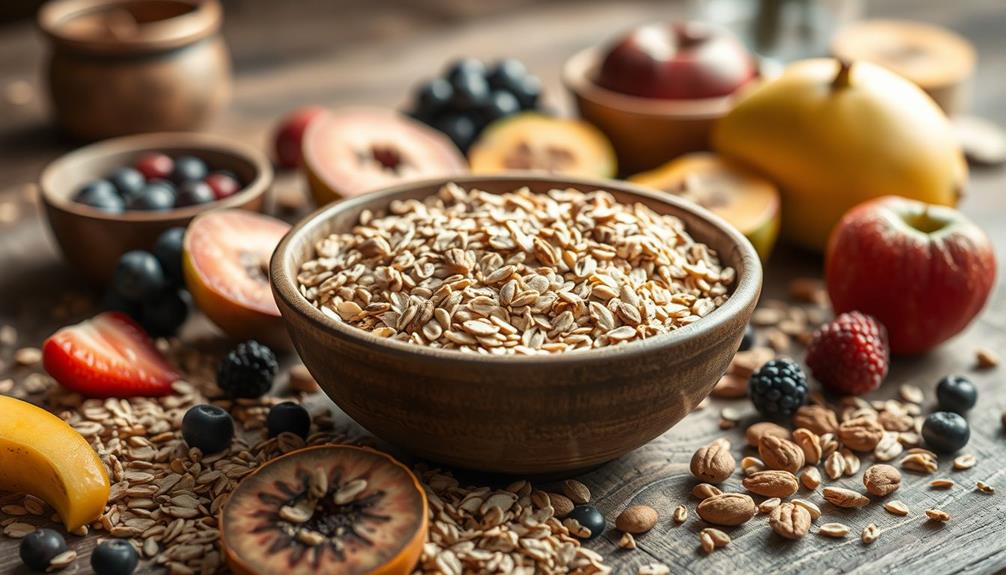
When considering oats as a part of your diet, it's important to think about nutrient retention and digestibility.
Raw oats offer a wealth of health benefits, especially when soaked to enhance their digestibility.
Additionally, incorporating herbal teas like chamomile alongside oats can promote relaxation and improve overall well-being.
Nutrient Retention in Oats
Although many people enjoy cooked oats for their warm, comforting texture, raw oats actually maintain more heat-sensitive nutrients that are beneficial for your health. When you choose raw oats, you're not just enjoying a crunchy snack; you're maximizing nutrient retention.
Cooking can lead to a loss of beneficial enzymes and vitamins, while raw oats keep these intact. Additionally, incorporating raw oats into your diet can support overall wellness, much like how certain essential oils for respiratory health can benefit your body. Soaking your raw oats for at least 12 hours enhances their digestibility and improves nutrient absorption. This means you can enjoy all the health benefits with less strain on your digestive system.
Here are some key benefits of raw oats:
- High in Soluble Fiber: The beta-glucan in raw oats supports heart health by helping to lower cholesterol.
- Rich Nutritional Value: They're packed with protein, fiber, magnesium, and antioxidants.
- Support Digestive Health: The fiber content aids digestion and promotes gut health.
- Retain Nutrients: You get more of those essential vitamins and enzymes that heat can destroy.
Incorporating raw oats into your diet is a fantastic way to enjoy their full range of health benefits while keeping your nutrient retention high.
Digestibility of Raw Oats
Maximizing nutrient retention in raw oats is just one part of the equation; understanding their digestibility is equally important for reaping their health benefits. Raw oats are rich in soluble fiber, particularly beta-glucan, which can enhance your digestive health and improve gut function.
Additionally, practices like yoga for back pain can complement your dietary choices by promoting overall wellness and reducing discomfort associated with digestive issues. However, the digestibility of raw oats can vary. If you consume them dry, you might experience digestive discomfort, so soaking raw oats for at least 12 hours is a smart approach. This process greatly improves their digestibility by reducing phytic acid, which inhibits mineral absorption and may lead to deficiencies over time.
Another consideration is that while cooking oats can further enhance their digestibility and reduce anti-nutritional factors, raw oats retain more heat-sensitive nutrients. So, if you're looking to maintain nutritional bioavailability, soaking is an excellent method to prepare your oats.
Health Benefits of Oats
Oats pack a powerful nutritional punch, making them an excellent choice for anyone seeking to improve their health. One of the standout features of oats is their high content of soluble fiber, particularly beta-glucan, which offers several impressive health benefits.
Additionally, the incorporation of oats into a balanced diet can support key domains of development in psychology by promoting overall well-being through proper nutrition.
- Lower cholesterol: Consuming oats can lower cholesterol levels by 5-10%, promoting better heart health.
- Blood sugar control: Just 4g of beta-glucan daily can lead to a 46% reduction in blood sugar levels after meals.
- Gut health: The dietary fiber in oats increases stool weight, aiding in constipation relief and promoting regularity.
- Weight management: Oats enhance feelings of fullness, helping you regulate appetite and reduce overall calorie intake.
Incorporating oats into your diet not only supports heart health and blood sugar levels but also contributes to your gut health.
Plus, the antioxidants in oats, like avenanthramides, may help reduce inflammation and improve skin health.
Safety and Storage Tips
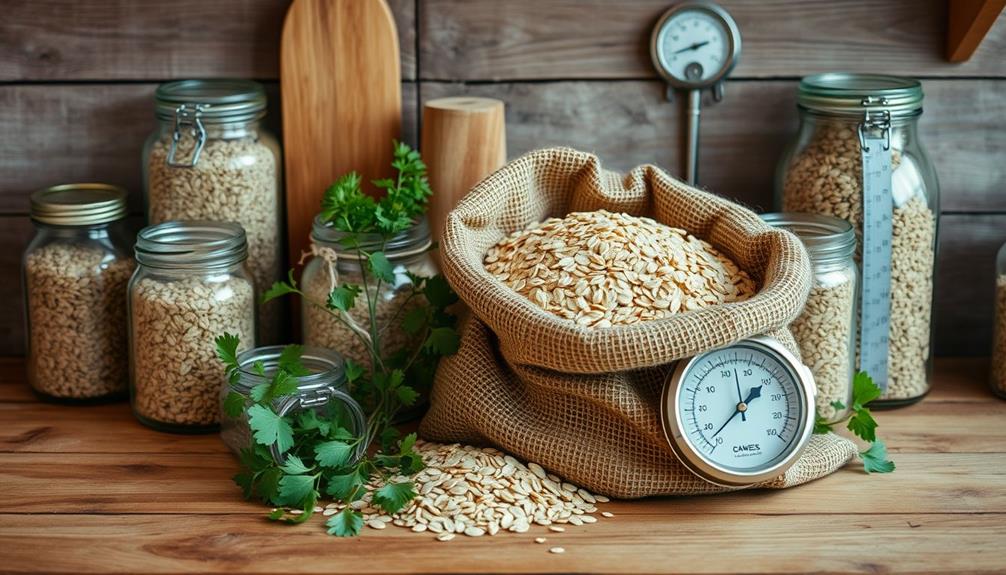
When it comes to storing your oatmeal, ensuring its freshness is key. To maintain the health benefits and flavor of your oats, store unopened oatmeal in a cool, dry place. This helps prevent spoilage and extends its shelf life.
Once you open your oatmeal, make sure to tightly cover it in a resealable bag or an airtight container. For ideal quality, try to use it within one year. Regular checks for signs of spoilage, such as unusual smells or discoloration, can help you avoid consuming bad oats. Additionally, incorporating fresh fruits or vegetables as safe snacks can provide added nutrition to your oatmeal diet, similar to how you'd care for your safe snacks for hamsters.
If you want to maximize shelf life even further, consider freezing dry oatmeal at 0°F. It can safely last up to a year in the freezer, so you won't have to worry about it going bad too quickly. However, keep an eye out for any off smells or flavors, as these may indicate spoilage, even if the quality dates haven't expired.
For those with gluten sensitivities, always opt for verified gluten-free rolled oats to avoid potential contamination during processing.
Community Insights on Oats

In recent years, the Rawtarian Community has become a valuable resource for anyone exploring the world of raw food, especially when it comes to oats. With over 5,000 members, this community actively shares their experiences and insights about how to incorporate oats into their raw food diets.
Members often discuss the differences in oat processing methods and how these can affect nutrition and safety. Many are particularly interested in sourcing non-heat-treated or truly raw oats, as they want to guarantee what they're consuming is safe to eat.
Here are some key insights from the community:
- Look for truly raw oats: Verify they haven't been processed with heat.
- Focus on quality sourcing: This helps avoid misleading product labels.
- Understand whole grain benefits: Whole grains offer numerous health advantages.
- Consult with fellow members: Sharing experiences can guide your oat choices.
The collective knowledge in the Rawtarian Community empowers you to navigate your choices regarding oats and other grains effectively, guaranteeing you enjoy the full benefits of this versatile food.
Exploring Alternatives to Oats

For those looking to expand their culinary horizons beyond oats, a variety of nutritious alternatives await. Oats are often a breakfast staple, but options like quinoa, buckwheat, and amaranth can easily take their place.
These grains share similar nutritional benefits, offering high fiber and protein content that make them excellent substitutes in various recipes.
Millet is another fantastic choice, especially when soaked overnight to enhance its digestibility. It provides a nutritious breakfast option that rivals oats.
If you're seeking something unique, consider incorporating sprouted grains into your meals. Sprouted quinoa and buckwheat not only taste great but also deliver additional health benefits and nutrients, appealing to those wanting to diversify their diet.
Research shows that these diverse grains contribute essential vitamins and minerals that support a balanced diet.
You may find that exploring alternatives to oats can cater to your individual dietary preferences while keeping your meals exciting.
As you experiment with these options, you'll discover a world of flavors and textures that can enrich your culinary experience while maintaining your nutritional intake.
Frequently Asked Questions
Are Oats Considered a Raw Food?
Oats can be considered raw food depending on the type. If you choose whole oat groats, they're raw. However, rolled and steel-cut oats usually undergo processing, so they're not truly raw. Always check labels.
Are Oats Natural or Man Made?
Picture a golden field swaying in the breeze; oats are as natural as the earth itself. You'll find they're cultivated from wild plants, not man-made, retaining their nutritional essence through various processing methods.
Did Ancient Humans Eat Oats?
Yes, ancient humans ate oats. They cultivated them for livestock and consumed them as porridge. In cooler climates, oats became a staple, showcasing their versatility in human diets across various ancient civilizations.
Did You Know Facts About Oats?
Did you know oats are incredibly nutritious? They're packed with fiber, protein, and essential vitamins. Soaking them overnight enhances digestibility and nutrient absorption, making them a fantastic addition to your healthy diet.
Conclusion
In summary, while you might think raw oats are a healthy choice, cooking them can enhance their nutritional benefits and digestibility. Don't let the idea of raw food scare you away from enjoying oats! By cooking them, you reveal their full potential and make them easier for your body to absorb. Plus, with so many delicious recipes, you'll never get bored. So go ahead, indulge in that warm bowl of oats and savor the goodness!

